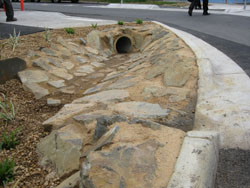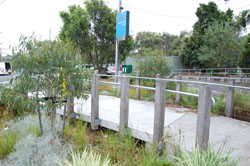resource library
Array
Each raingarden incorporates a tiered design approach which overcomes the site constraints posed by the very steep gradient

Inflows into the raingardens include catchment-wide runoff and direct street runoff

A boardwalk was installed over the raingarden to facilitate pedestrian movement
Were Street Raingardens
Banyule City Council
Were Street, Montmorency, Victoria | Map:
Published: 29 March 2012
Project Overview
In 2009, Banyule City Council commenced a streetscape upgrade near the entrance to the Montmorency train station, a previously large asphalt expanse. The upgrade provided an opportunity to improve the public amenity of the area through the delivery of one of Banyule's first Water Sensitive Urban Design (WSUD) assets.
This small scale project is a great demonstration on how WSUD can be implemented on challenging sites in urban areas. The design features separate raingarden systems, totalling a treatment area of 120m2. This facilitates movement and access in this high activity area used by pedestrians, commuters and vehicles.
Each raingarden incorporates a tiered design approach which overcomes the site constraints posed by the very steep gradient. The different levels add to the aesthetics of the system but also improve the water quality treatment level: The treated outflow is directed from the base of each raingarden level through to the top of the next one.
Drivers and Objectives
To provide an enhanced setting and sense of place through a streetscape upgrade.
To ensure pedestrian movement and access is maintained throughout the site.
To provide stormwater treatment that meets best practice guidelines as directed in the Council's Environmental Sustainability Policy.
Organisations
Banyule City Council (Responsible Council)
Melbourne Water - Living Rivers Program (Funding Partner)
CPG Australia Pty Ltd (Consultant)
Project Outcomes
This project provides an enhanced setting and engaging space for the community in a location that is Montmorency's key focus for retail and transport activities.
As the project is located directly in line with the main pedestrian entry for the Montmorency train station, a boardwalk was installed over the raingarden to facilitate pedestrian movement.
This project sees a transformation of what was previously a large asphalt expanse converted to a green streetscape asset planted with a range of native plants, contributing to a reduction in the Urban Heat Island effect.
Treating the catchment's stormwater runoff through a series of raingardens achieves a reduction in peak flows as well as a decrease in pollutant loads entering the Plenty River (such as sediment and nutrients).
Strong public support following the completion of the raingarden has improved the perception of WSUD amongst council senior management.
Lessons Learnt
Key advocates for the project realised that, at the internal approvals stage, they could have put greater emphasis on the multiple benefits brought about by the streetscape upgrade (environmental, amenity, reputation, community satisfaction, etc.). Indeed, highlighting the multiple benefits of a project early on will ensure that decision makers do not focus solely on financial aspects.
The raingarden system implemented in Were Street is a simple but key amenity that integrates stormwater assets into the life of the street. The central location of the system provides the opportunity to build awareness around WSUD as a crucial component of the transition to water sensitive cities. In addition, good communication contributed to local understanding. The site has already been a destination for informal industry WSUD tours and has stimulated knowledge sharing with peers.
Banyule City Council has identified the importance of developing a WSUD design and implementation flowchart that assigns project responsibilities at all stages of the project.
This project had to undergo significant design variations from the concept plans, due to an underestimate of project costs at the concept stage. After tender, the scope of the works had to be reduced in order to fit the initial available budget.
Project Cost
$120,000 (WSUD Construction Budget), $82,500 of which was funded by the Living Rivers Program
Timeframe
2009 - 2011
Contact
John Milkins
john.milkins@banyule.vic.gov.au
